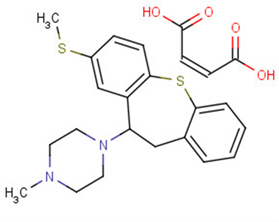
Methiothepin maleate
CAS No. 19728-88-2
Methiothepin maleate( Methiothepin Maleate | Metitepine | HCVIN281816 )
Catalog No. M18192 CAS No. 19728-88-2
Methiothepin is a 5-HT1, 5-HT6, 5-HT7 serotonin receptor antagonist, which blocks serotonin autoreceptors.
Purity : >98% (HPLC)
 COA
COA
 Datasheet
Datasheet
 HNMR
HNMR
 HPLC
HPLC
 MSDS
MSDS
 Handing Instructions
Handing Instructions
| Size | Price / USD | Stock | Quantity |
| 50MG | 56 | Get Quote |


|
| 100MG | 102 | Get Quote |


|
| 500MG | 381 | Get Quote |


|
| 1G | Get Quote | Get Quote |


|
Biological Information
-
Product NameMethiothepin maleate
-
NoteResearch use only, not for human use.
-
Brief DescriptionMethiothepin is a 5-HT1, 5-HT6, 5-HT7 serotonin receptor antagonist, which blocks serotonin autoreceptors.
-
DescriptionMethiothepin Maleate is an inhibitor of HCV infection and cell-to-cell transmission that acts by targeting the HCV E2 glycoprotein.
-
In VitroMethiothepin maleate is a 5-HT receptor antagonist, with pKds of 7.10, 7.28, 7.56, and 6.99 for 5-HT1A, 5HT1B, 5HT1C, 5HT1D. Methiothepin mesylate also shows pKds of 7.0, 7.8, 8.74, and 8.99 for 5-HT5A, 5-HT5B, 5-HT6, and 5-HT7, respectively. Methiothepin exhibits high affinity at 5-HT2A, 5HT2B, and 5HT2C with pKis of 8.50, 8.68, and 8.35, respectively.
-
In Vivo——
-
SynonymsMethiothepin Maleate | Metitepine | HCVIN281816
-
PathwayOthers
-
TargetOther Targets
-
Recptor5-HT1|5-HT6|5-HT7
-
Research Area——
-
Indication——
Chemical Information
-
CAS Number19728-88-2
-
Formula Weight472.62
-
Molecular FormulaC24H28N2O4S2
-
Purity>98% (HPLC)
-
Solubility——
-
SMILESCN1CCN(CC1)C2CC3=CC=CC=C3SC4=C2C=C(C=C4)SC.C(=CC(=O)O)C(=O)O
-
Chemical Name1-Methyl-4-(3-methylsulfanyl-5,6-dihydrobenzo[b][1]benzothiepin-5-yl)piperazine Maleate
Shipping & Storage Information
-
Storage(-20℃)
-
ShippingWith Ice Pack
-
Stability≥ 2 years
Reference
1. Knight J A, etal. Molecular Pharmacology, 2009, 75(2):374-380.
molnova catalog



related products
-
Cirsiliol
Cirsiliol is a selective inhibitor of 5-lipoxygenase and a competitive low-affinity ligand of benzodiazepine receptors.
-
Thalidomide 5-fluori...
Thalidomide 5-fluoride is a chemical compound.
-
Diclofop-methyl
Diclofop-methyl is used as the active ingredient in many herbicides that are used to control weed growth in plants such as wheat and wild oats.



 Cart
Cart
 sales@molnova.com
sales@molnova.com


